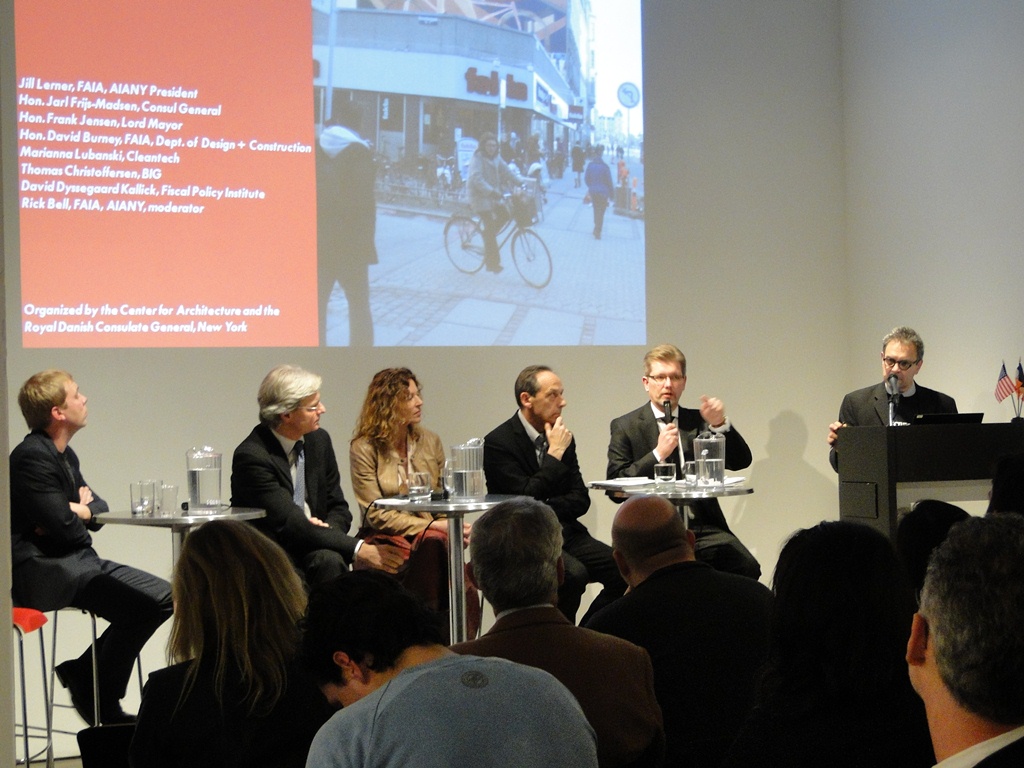by Bill Millard
Awaken a New Yorker in the middle of the night and ask what the name Copenhagen brings to mind: the answer will probably be bikes. Yet its enthusiastic embrace of cycling is just one of many ways the Danish capital is a model for other cities’ efforts to increase sustainability and resilience.
2013 AIANY President Jill Lerner, FAIA, recounted that there has been a series of exchanges with Danish architects at the Center for Architecture over recent years. The New York architecture community has been brought in contact with Jan Gehl’s walkable-scale urbanism, Marianne Ibler’s humanely crafted designs and writings, Bjarke Ingels Group’s (BIG) advocacy of “hedonistic sustainability,” and others. Now, as local transportation and public-space policy implements Gehl’s recommendations, and BIG’s pyramidal West 57th Street building approaches approval and construction, this opening event of Lerner’s AIANY term suggested a vision of what a more fully Copenhagenized New York might look like – and what this global city stands to gain if certain global practices, including political ones, can become its own as well.
Copenhagen and New York are different-scaled cities with radically different political cultures, but over recent decades they share a broad trajectory, as Mayor Frank Jensen and NYC Department of Design + Construction Commissioner David Burney, FAIA, both pointed out: a period of decay, some strategic policy rethinking, and a dramatic renaissance marked by repopulation and a rising quality of life. Twenty years ago, Jensen noted, “Copenhagen was a gloomy industrial city on the brink of economic collapse.” Its successful reversal, panelists argued, has pivoted on a factor that New York and many other cities would be wise to encourage: not just a broad commitment to emission reduction, recycling, and better energy performance – things that every responsible city now plans for – but long-term growth in clean, green jobs.
Copenhagen’s achievements debunk the hair-shirt model of greenness; that is, the assumption that sustainability requires austerity at odds with economic growth. This optimism is not to be confused with naïveté: the youthful Mayor Jensen, tempering his enthusiasm with caution about broader conditions, noted that for both Europe and the U.S., the current economic crisis is the worst since World War II and could become a broader political crisis if job creation remains elusive. Smart growth, with a prominent technology sector, is Copenhagen’s solution to the riddle of balancing ecologic and economic values.
“I believe that we have to transform our economies in a more environmental-friendly and more resource-efficient direction,” he stated, quoting Organization for Economic Co-operation and Development (OECD) Secretary-General Angel Gurría’s remark that “it is no longer an option to go green; there are simply not enough natural resources to sustain longer-term economic growth.”
As the OECD has reported, Jensen continued, Copenhagen has become a world leader in green urbanism, marshaling “close involvement and cooperation of citizens, private companies, and universities” to achieve remarkable measures of progress. Population is up 20%, the harbor is clean enough to swim in, half of government ministers commute by bike, and the city is on track for a 40% reduction in CO2 emission between 1995 and 2020. The local economy is strong enough to support billions of kroner worth of public investment in schools, day care, public transport, energy infrastructure, retrofitted buildings, new neighborhoods, and other markers of advanced civilization. “My ambition is to turn Copenhagen into an urban laboratory for artistic new green solutions that can help solve our problems,” he said, “and in other cities as well…. It’s all about livability for our citizens.”
Marianna Lubianski, who leads the Copenhagen Cleantech Cluster (a public-private “one-stop shop” for business and research), noted that this was the only sector of the economy that kept thriving through the global economic crisis that began in 2008. Forty years’ experience with wind energy, she also noted, contributes to national security by lowering oil dependence.
The Copenhagen model of constructive public-private partnership also requires a political consensus to support technology, transportation rebalancing, and affordable housing. As the Fiscal Policy Institute’s David Kallick observed, the severe economic polarization that characterizes New York’s economy is something the Danes would not tolerate. Thomas Christoffersen of BIG emphasized the need for architects to ask, as an integral part of each project, “how our building can contribute to the public realm.” Jensen uses the public budget as a tool for innovation, and businesses in Denmark manage to live peaceably with regulation. Consequently, Kallick wryly noted, Copenhageners “learn to live with higher standards.”
Event: Copenhagen Says: Green-up Your City! A Talk with Frank Jensen, Lord Mayor of Copenhagen
Location: Center for Architecture, 01.09.2013
Speakers: Frank Jensen, Lord Mayor, City of Copenhagen; Jarl Frijs-Madsen, Consul General, Ambassador, Royal Danish Consulate General; David Burney, FAIA, Commissioner, NYC Department of Design + Construction (DDC); Marianna Lubanski, Cleantech Director, Copenhagen Capacity; Thomas Christoffersen, Partner, Bjarke Ingels Group/BIG; David Dyssegaard Kallick, Senior Fellow, Fiscal Policy Institute; Jill N. Lerner, FAIA, Kohn Pedersen Fox Associates, President, AIANY (introduction); Rick Bell, FAIA, Executive Director, AIANY (moderator)
Organizers: Center for Architecture and the Consulate General of Denmark, New York
Sponsors: Center for Architecture, the Consulate General of Denmark in New York, and the Lord Mayor’s Office, Copenhagen
Bill Millard is a freelance writer and editor whose work has appeared in Oculus, Icon, Content, The Architect’s Newspaper, and other publications.


